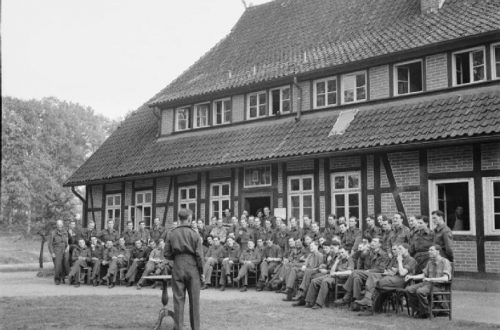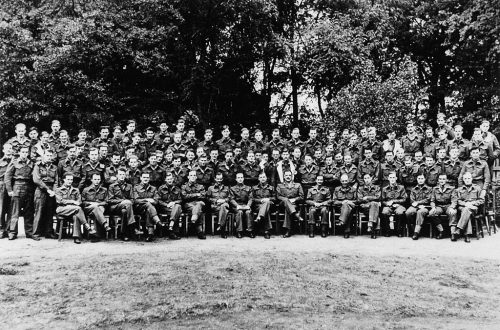Arnold Peter Meiklejohn
Arnold Peter Meiklejohn (1909 – 14 June 1961), known as Peter Meiklejohn, was an English physician and academic, specializing in nutrition.
In 1938, he was elected as a Peabody Fellow of the Harvard Medical School and during the Second World War worked for the Rockefeller Foundation and as nutrition adviser to UNRRA. In 1945, shortly after the liberation of Bergen-Belsen concentration camp, Meiklejohn was put in charge of administering a starvation diet to the camp’s severely malnourished and dying inmates.
On 29 April 1945, Meiklejohn arrived at Bergen-Belsen concentration camp shortly after its liberation by British forces, with the responsibility of administering the starvation diet to the severely malnourished and dying inmates.
He led one of two teams sent on behalf of UNRRA, the other team being led by Janet Vaughan. At the time, the death rate at the camp was estimated at 500 or 600 per day when he was sent volunteer medical students from London medical schools, to assist him in camp 1, at the request of Brigadier Hugh Glyn-Hughes and the War Office. Here, typhus and starvation were prevalent. They included Michael Hargrave, whose diary, later published as Bergen-Belsen 1945: A Medical Student’s Journal, details his month-long experience at the camp and describes the introductory briefing on the challenges they would face, given by Meiklejohn. Other students included Alex Paton who published his memoirs of Belsen in the British Medical Journal in 1981 and David Philip Bowler who later had a career in community child health, for which he was awarded the Advance Australia Award for his work in the care of Aboriginal children. Some of the students memoirs were used by author Ben Shephard in the book After Daybreak: The Liberation of Belsen, 1945. On being questioned about the achievements of the students, Meiklejohn responded that “they had restored the moral order”.
Feeding in camp I of Belsen was a major problem. Generous rich food was not tolerated by inmates who had starved for so long. Despite a number of cookhouses and co-ordinating offices, simply handing out food was not enough. Meiklejohn wondered why a mixture that worked so well in Bengal was so disastrous in Belsen. It was, according to the rabbi Reverend Leslie Hardman, “revoltingly sweet”. Meiklejohn postulated that the unpopular Bengal mixture, made of dried milk, flour, sugar and molasses which was used in the Bengal famine of 1943 likely halved the death rate from starvation. People in the students’ hospital lived due to the work of the students and he commended them for their organisation. The mixture was much too sweet for eastern Europeans.
Meiklejohn also led the postmortems of some of those that died by starvation and his findings included extreme muscle wasting, swollen ankles and feet, small hearts and fluid around the heart. Almost all of those that had postmortems had tuberculosis (TB) of varying types including miliary tuberculosis and chronic TB. The stomach was sometimes found to be small from atrophy or large from gaseous distension and the large intestine could be atrophied or ulcerated.
After the war, he became a lecturer in nutrition at the University of Edinburgh and in 1947, at the request of the Medical Research Council (MRC), assessed and reported on the state of nutrition of German civilians.
He wrote a number of papers on nutrition, particularly on errors of metabolism, and with Sir Stanley Davidson and R. Passmore was co-author of the textbook Human Nutrition and Dietetics (1959).
Personal Life
In 1950, Meiklejohn was on the electoral register for Edinburgh West at 9, St Bernards Crescent, with Margaret L. Campbell-Renton. In 1960, he was at 8a, Fountainhall Road, in Edinburgh South, with Jean S. Meiklejohn.
Known as Peter, and not Arnold, Meiklejohn was married to Jean, and they had two sons, who were small boys at the time of his death on 14 June 1961, in an accident while fishing in a Highland river. He was 51.
His obituary in the British Medical Journal enumerated some of his quirks, saying; “He had many amusing and endearing foibles; there were his oddities of dress, his dilapidated motor-car, his inveterate snuff-taking, and his refusal to drink coffee at lunch as he said it disturbed his post-prandial nap-normally enjoyed on the floor of his room in the Department of Medicine with his head resting on a green velvet pillow specially designed for the purpose.”
5,674 total views


